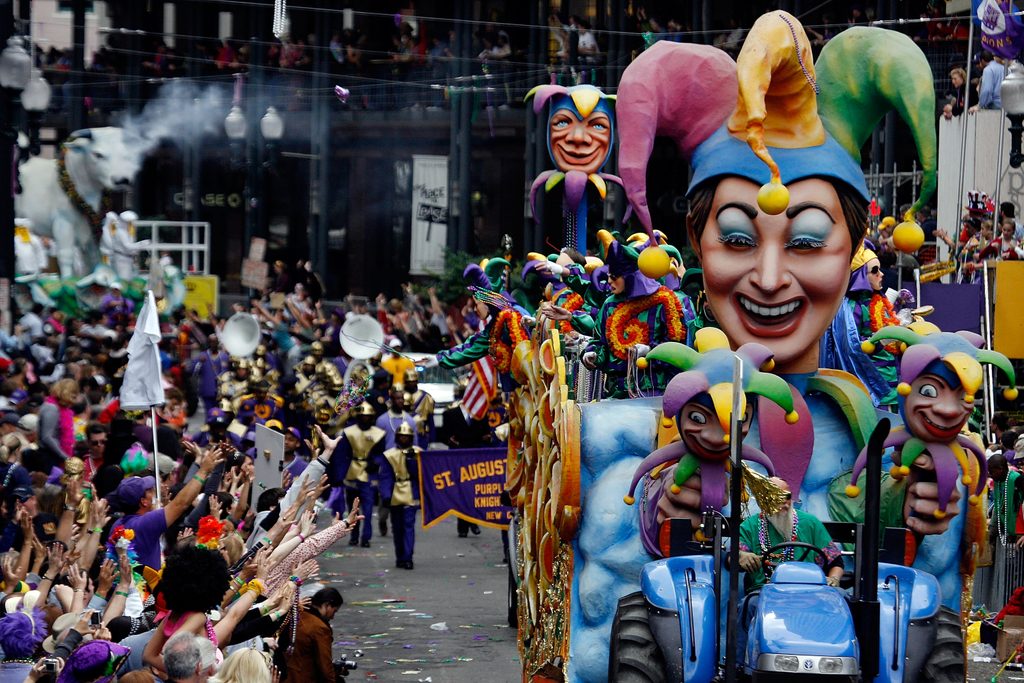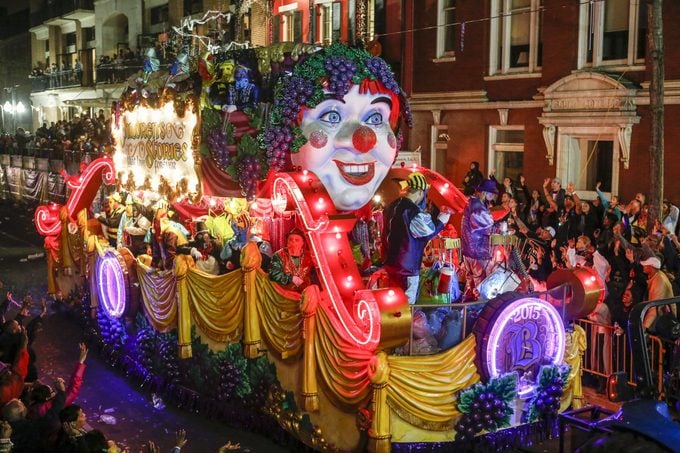Why Do Mardi Gras Float Riders Have to Wear Masks?
Updated: Feb. 06, 2024

There's a reason Mardi Gras in New Orleans is called "The Greatest Free Show on Earth." It's a larger-than-life party where any and everything goes—and that's part of the reason masks are worn.
Back in the late 1700s, when the first unofficial Mardi Gras parades were held in New Orleans, revelers wore masks because it allowed them to “escape society and class constraints,” reports the website, Mardigrasneworleans.com. They could do what they want and speak or flirt with people of different classes while their true identities were hidden. That said, the era was not without judgment as “women who wore masks had their reputation questioned,” notes the site.
History of Mardi Gras masks
The origins of Mardi Gras date back even further to medieval Europe and it celebrates the period before Lent, the 40 days leading up to Easter when many people fast. Some historians theorize that the roots of the holiday go back even further to ancient Rome and the festival of Lupercalia, which was held in mid-February. The festival celebrated the season of fertility and involved animal sacrifices, feasting, and random sexual couplings. The celebration of the holiday may have been incorporated into Lent, as the Catholic Church began converting pagans and figured it would be easier to do so if they let them keep their holiday, or so the thinking goes.
After Mardi Gras made its way to the United States, masked balls flourished under French rule in the late 1700s, but were later banned by the Spanish governors. The prohibition continued when New Orleans became an American city in 1803, but by 1823, the Creole populace prevailed upon the American governor, and balls were again permitted. Four years later street masking was officially made legal, according to Arthur Hardy’s Mardi Gras Guide.
Today, masks continue to be at the heart of the spirit of Mardi Gras. “Riding on a float is a privilege and wearing a mask is sacred,” notes Jonathan Bertucceli, a third-generation float maker and owner of Studio 3, a design studio that makes Mardi Gras floats. “You’re supposed to cut loose—and with a mask, you can act as foolish as you want and nobody knows who you are.” And that’s exactly what folks do, especially in the French Quarter. “You don’t bring your children down there; every year there’s someone without all their clothes on. It’s X-rated,” he says.
Learn about the king cake while you’re in the spirits of Mardi Gras!
A mask is not just a mask
 “Wearing the mask is the custom, part of the mystique of carnival. You’re not supposed to know who is one the float throwing you gifts [beads, cups, and other trinkets],” says Arthur Hardy. Fun and games aside, wearing a mask is serious business—and it’s required by law if you’re riding on a Mardi Gras float, though at all other times of the year, it’s against the law in Louisiana to wear a mask in public.
“Wearing the mask is the custom, part of the mystique of carnival. You’re not supposed to know who is one the float throwing you gifts [beads, cups, and other trinkets],” says Arthur Hardy. Fun and games aside, wearing a mask is serious business—and it’s required by law if you’re riding on a Mardi Gras float, though at all other times of the year, it’s against the law in Louisiana to wear a mask in public.
It’s not just the law you would be breaking, but krewe (the clubs that put on the various parades and balls) rules, too. “Many organizations film the parade. If you’re caught without your mask, not only are you thrown out of the krewe, you could be fined $500,” says Hardy. You’ll be fined because it’s a major breach of the Krewe code.
Appreciate the art
There are people pouring their souls and skills into crafting the masks worn on Mardi Gras. Take for example Maskarade, a New Orleans shop where you can find an array of masks. Browse the gallery on their website and you’ll see the level artistry. “Our mission at Maskarade is to bring joy, happiness and a bit of mystery with our Masks. As Oscar Wilde once said, ‘Give a man a mask and he will reveal his true self,'” beckons the website.